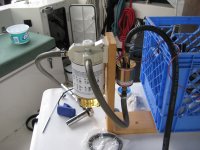Pat Anderson
New member
Our great vacation was marred only a little by a somewhat inconvenient situation of water in the gas tank. We replaced the fuel-water separator cartridge and emptied the bowl with the water sensor under the cowling, and when the alarm went off, we shut down and drained the bowl under the cartridge. This method allowed us to cruise for hours at at a time before the alarm went off, but I obviously need to address this before heading to Lake Powell in 6 weeks or so.
So some questions:
1. Best way to drain all the fuel out of the tank (it is now about half full, maybe 50 gallons)? Would a hobby pump like this work if I remove the quick disconnect and add some additional hose? [On edit: this one looks like the ticket, but it is a little pricey...]
2. There is really very little water in what I am getting now. How about just treating it with Heet in the red bottle?
3. Is there some kind of fuel water separator that has a sensor so you can drain it BEFORE it gets to the engine? It seems like with the crappy gas we have now, a dual fuel water separator with sensor setup would be the best prevention, no?
I have a place here to get ethanol free gas (the Cenex store in Ferndale, if you are ever in Whatcom County, WA), and will treat it with regular Stabil, once I have the water all out of the tank. I have been using regular Stabil, not the blue Stabil or Seafoam, so maybe I have just been skating for some time and this was bound to pop up.
Anyway, thanks for any (good) advice!
So some questions:
1. Best way to drain all the fuel out of the tank (it is now about half full, maybe 50 gallons)? Would a hobby pump like this work if I remove the quick disconnect and add some additional hose? [On edit: this one looks like the ticket, but it is a little pricey...]
2. There is really very little water in what I am getting now. How about just treating it with Heet in the red bottle?
3. Is there some kind of fuel water separator that has a sensor so you can drain it BEFORE it gets to the engine? It seems like with the crappy gas we have now, a dual fuel water separator with sensor setup would be the best prevention, no?
I have a place here to get ethanol free gas (the Cenex store in Ferndale, if you are ever in Whatcom County, WA), and will treat it with regular Stabil, once I have the water all out of the tank. I have been using regular Stabil, not the blue Stabil or Seafoam, so maybe I have just been skating for some time and this was bound to pop up.
Anyway, thanks for any (good) advice!

